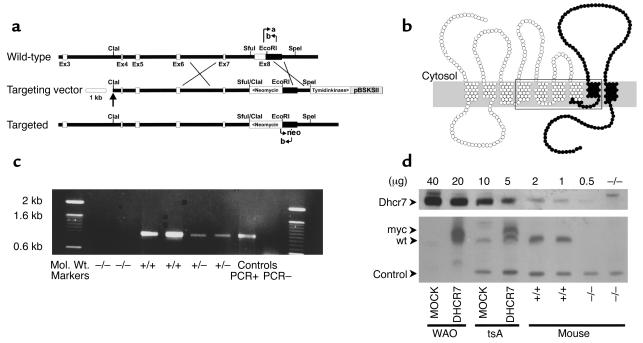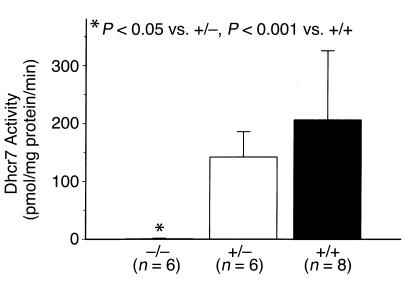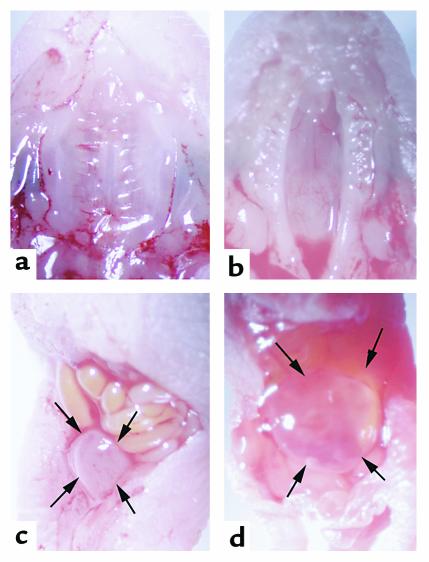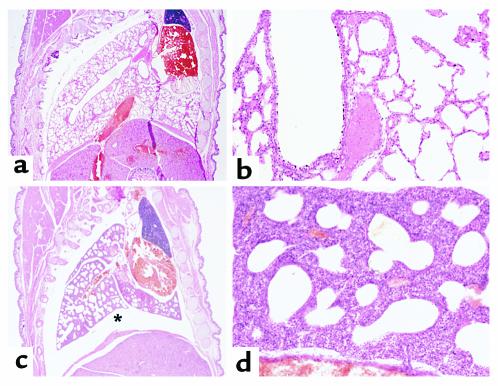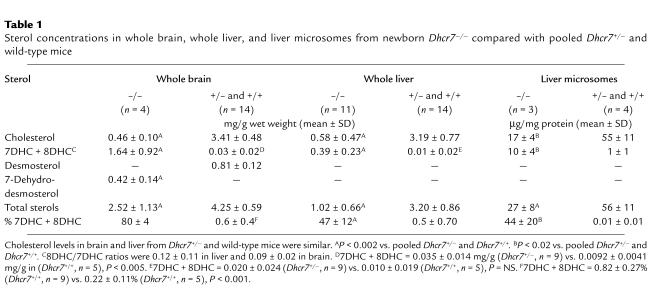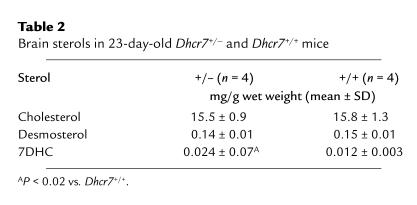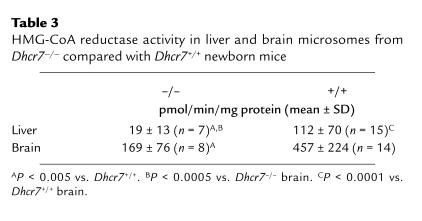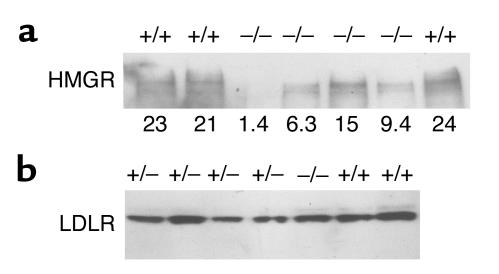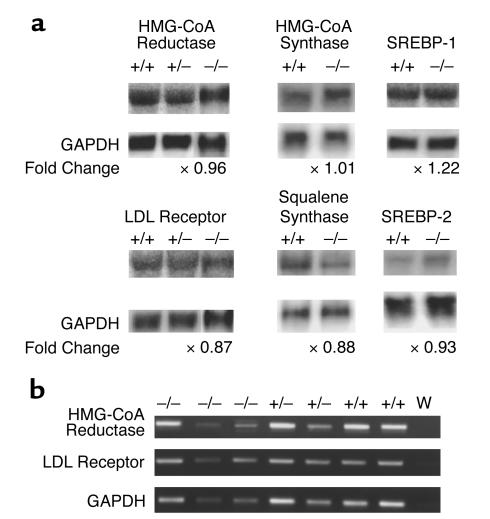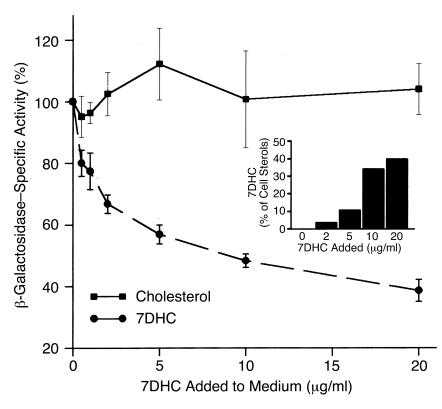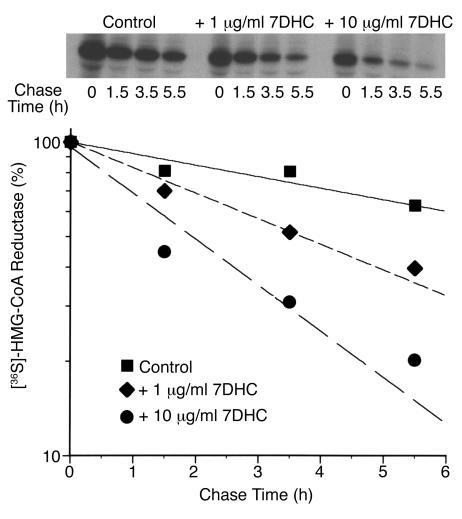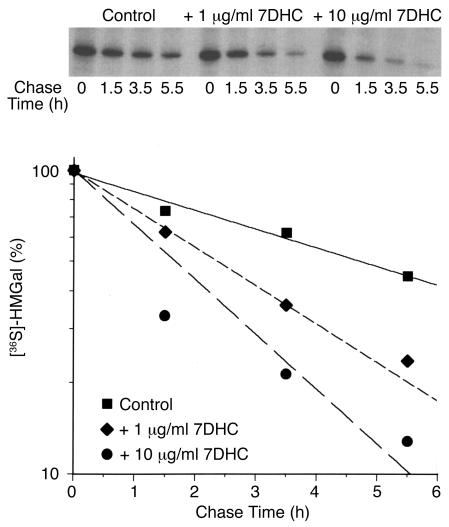Abstract
Smith-Lemli-Opitz/RSH syndrome (SLOS), a relatively common birth-defect mental-retardation syndrome, is caused by mutations in DHCR7, whose product catalyzes an obligate step in cholesterol biosynthesis, the conversion of 7-dehydrocholesterol to cholesterol. A null mutation in the murine Dhcr7 causes an identical biochemical defect to that seen in SLOS, including markedly reduced tissue cholesterol and total sterol levels, and 30- to 40-fold elevated concentrations of 7-dehydrocholesterol. Prenatal lethality was not noted, but newborn homozygotes breathed with difficulty, did not suckle, and died soon after birth with immature lungs, enlarged bladders, and, frequently, cleft palates. Despite reduced sterol concentrations in Dhcr7–/– mice, mRNA levels for 3-hydroxy-3-methylglutaryl coenzyme A (HMG-CoA) reductase, the rate-controlling enzyme for sterol biosynthesis, the LDL receptor, and SREBP-2 appeared neither elevated nor repressed. In contrast to mRNA, protein levels and activities of HMG-CoA reductase were markedly reduced. Consistent with this finding, 7-dehydrocholesterol accelerates proteolysis of HMG-CoA reductase while sparing other key proteins. These results demonstrate that in mice without Dhcr7 activity, accumulated 7-dehydrocholesterol suppresses sterol biosynthesis posttranslationally. This effect might exacerbate abnormal development in SLOS by increasing the fetal cholesterol deficiency.
Introduction
A number of birth defect–malformation syndromes, first characterized by their clinical features, have since proven to be metabolic disorders caused by abnormalities in enzymes essential for cholesterol biosynthesis (1–6). The most common of these, with an estimated frequency of 1 in 10,000 to 40,000 Caucasian births (7–9), is Smith-Lemli-Opitz/RSH syndrome (SLOS; MIM 270400) (10) characterized by a dysmorphic facial appearance; palatal clefting; two-three toe syndactyly; postaxial polydactyly; malformations of heart, kidney, genitalia, and lungs; occasional holoprosencephaly; severe to profound mental retardation; and failure to thrive (10, 11). SLOS is caused by mutations in DHCR7, the gene that codes for 3β-hydroxysteroid Δ7-reductase (E.C.1.3.1.21), the enzyme that catalyzes the reduction of the Δ7 double bond of 7-dehydrocholesterol (7DHC) (cholesta-5,7-dien-3β-ol) to form cholesterol (cholest-5-en-3β-ol) (12–15). As a result, cholesterol biosynthesis is hindered, leading to reduced plasma and tissue cholesterol concentrations and the accumulation of 7DHC and its epimer 8DHC (cholesta-5,8-dien-3β-ol) in all tissues (12, 16–18).
Cholesterol plays an essential role in development because it is needed to activate the morphogenic sonic hedgehog (SHH) signal pathway during early gestation (19), and adverse effects of cholesterol deprivation in the prenatal period are amply illustrated in SLOS by the strong inverse dependence of symptom severity and perinatal mortality on plasma cholesterol levels (8, 20). In contrast to cholesterol, 7DHC fails to stimulate the SHH pathway (21). 7DHC also appears to be an especially potent inhibitor of 3-hydroxy-3-methylglutaryl coenzyme A (HMG-CoA) reductase (22), the rate-limiting enzyme for cholesterol biosynthesis, explaining why plasma total sterol and mevalonic acid concentrations (16, 23, 24) and rates of sterol biosynthesis, as measured by sterol balance (25), are reduced by an average of 40–50% in SLOS.
To explore the mechanisms by which 7DHC inhibits sterol biosynthesis, the mouse Dhcr7 gene was mutated by homologous recombination to create an animal lacking measurable Dhcr7 activity. Except for low 8DHC/7DHC ratios, the biochemical phenotype in the mice was indistinguishable from that in SLOS, and several physical and metabolic abnormalities found in newborn Dhcr7–/– mice have their counterparts in affected children. As in SLOS, sterol biosynthesis was highly abnormal in homozygous mice. HMG-CoA reductase, LDL receptor, and sterol response element–binding protein-2 (SREBP-2) mRNA levels were found to be similar to levels measured in heterozygous and wild-type littermates, yet tissue total sterol concentrations and HMG-CoA reductase protein levels and activities were markedly reduced. Ancillary in vitro studies provided the explanation for this seemingly paradoxical result, demonstrating that 7DHC accelerates proteolysis of HMG-CoA reductase enzyme several fold. Thus, in the Dhcr7-null mouse, as in children with SLOS, elevated concentrations of 7DHC suppress cholesterol synthesis, exacerbating the sterol deficiency and further contributing to abnormal development.
Methods
Generation of Dhcr7–/– mice (Dhcr7Ex8).
A genomic cosmid clone from mouse strain 129Ola (clone MPMGc121P1353Q3) containing the entire Dhcr7 gene was obtained from the Resource Centre/Primary Database (Berlin, Germany) (15). The targeting construct in pBluescript KSII (Figure 1a) contained two fragments of genomic Dhcr7 DNA, a 1.6-kb neomycin resistance gene under control of the phosphoglycerokinase (PGK) promoter from pKO SelectNeo (Lexicon Genetics, The Woodlands, Texas, USA) in opposite orientation to the transcription of Dhcr7 and a 2-kb thymidine kinase gene from pKO SelectTK (Lexicon Genetics). The 5′-region of homology was a 6.6-kb Dhcr7 ClaI-SfuI fragment comprising mouse exons 4–7 (corresponding to human exons 5–8). The 3′-region of homology was a 1.4-kb EcoRI-SpeI fragment that included the entire 3′-untranslated region of exon 8 (corresponding to human exon 9) and an additional nontranscribed genomic sequence (Figure 1a). Electroporation of embryonic stem (ES) cells (E14TG2a) was carried out as described (26). Four correctly targeted ES cell clones were identified by PCR and homologous recombination was confirmed by Southern blot analysis. C57Bl/6 blastocysts were injected with the correctly targeted ES cells and implanted into pseudopregnant C57Bl/6 females. Chimeric mice were identified by their coat color (agouti) and bred. Several pups carrying the modified Dhcr7 gene were identified, indicating that the mutation had passed into their germ cells. For genotype analysis, 450 bp of exon 8 of the wild-type gene was amplified using primer a, 5′ggatcttctgagggcagcctt, and primer b, 5′tctgaacccttggctgatca, while the 320-bp fragment of the mutant allele was amplified by primers neo, 5′ctagaccgcggctagagaat, and primer b (Figure 1a).
Figure 1.
(a) Disruption of the Dhcr7 gene. The coding sequence of exon 8 and the 5′ flanking splice acceptor site and part of the 3′ flanking untranslated region (indicated in gray) of the wild-type gene were replaced with a neomycin resistance gene in opposite orientation to Dhcr7 transcription. Restriction sites used for subcloning of short and long Dhcr7 gene segments are shown. The targeting construct was linearized with ClaI (arrow). Primers employed for PCR genotyping are labeled a, b, and neo (see Methods). (b) Tentative topology model of Dhcr7. The induced Dhcr7 mutation is expected to delete one-third of the Dhcr7 protein (the residues shown as filled circles). The box indicates the putative sterol-binding site REF. (c) Total RNA extracted from the livers of Dhcr7–/–, Dhcr7+/–, and wild-type newborn mice was reverse transcribed and amplified using specific primers for the 3′-end of Dhcr7 mRNA and GADPH. (d) Immunoblot analysis of Dhcr7. Upper panel: Loading decreasing amounts of total hepatic protein results in corresponding reductions in Dhcr7 Ab response. Lower panel: Microsomal protein from yeast (WA0) and human tsA-201 cells (tsA) heterologously expressing DHCR7 with an N-terminal myc tag (15) and from livers of newborn wild-type mice demonstrated immunoreactive Dhcr7 protein. Bands corresponding to myc-tagged (myc) and wild-type (WT) DHCR7/Dhcr7 proteins, respectively, are indicated by arrowheads. In contrast, no immunoreactive band corresponding to wild-type Dhcr7 was detected in 40 μg of microsomal protein from either homozygous mice (last two lanes) or mock-transfected yeast (MOCK).
Immunoblot analysis of Dhcr7 expression was carried out by separating proteins on 14% SDS-polyacrylamide gels, then analyzing them by immunoblotting with 1 mg/ml α-DHCR7454-467 as described previously (15). Loading of the gels with total liver protein over a range 80:1 results in corresponding reductions in Dhcr7 antibody response (Figure 1d, upper panel). In the lower panel of Figure 1d, microsomal protein from yeast strains (WA0) and human tsA-201 cells (tsA) heterologously expressing DHCR7 with an N-terminal myc tag (15) and from livers of newborn mice of the indicated genotype were separated. Equal loading was verified by coincubation with antibodies against the ς1-receptor (control) as described (15). No DHCR7 was detected in mock-transfected yeast (MOCK), while the level of immunoreactive protein was markedly increased in transfected compared with mock-transfected tsA cells.
Affinity-purified polyclonal Ab’s (α-DHCR7454-467), raised in rabbits against amino acid residues 454-467 (YGRDWERYTAAVPY) of human DHCR7, were purchased from BioChem Pharm (Salzburg, Austria).
Biochemical measurements.
Sterols were purchased from Steraloids Inc. (Newport, Rhode Island, USA), except 7-dehydrodesmosterol (cholesta-7,24-dien-3β-ol), which was obtained from the plasma of a rat 72 hours after the simultaneous administration of the Δ7-reductase inhibitor BM 15.766 and the Δ24-reductase inhibitor triparanol. Tissue sterols were measured as their trimethylsilyl ether derivatives using capillary column gas chromatography (GC) (12, 27), while microsomal sterols, sterols from cultured cells, and 7DHC in Dhcr7+/– and wild-type pups were quantitated using GC/selected ion-monitoring mass spectrometry by measuring the intensities of the 329, 325, and 343 m/z peaks for cholesterol, 7DHC, and desmosterol, respectively (22, 28). Because 7DHC and desmosterol have similar GC retention times 7DHC levels in tissues from Dhcr7+/– and wild-type animals, especially brain, were corrected for the presence of desmosterol by using 325:343 m/z ratios. Glucose was measured with a Fast Take glucometer in blood obtained by decapitation less than 12 hours after birth.
Enzyme activities.
Dhcr7 activity was assayed by a modification of the method described by Shefer et al. (13) because we found it necessary to use whole tissue homogenate rather than microsomes to achieve reproducible results. Briefly, 0.5 mg protein was incubated in 150 μl of 100 mM phosphate buffer (pH 7.4) containing a NADPH-generating system plus 30 nmol of [3H]-7DHC (25,000 dpm). HMG-CoA reductase activities were measured in isolated liver and brain microsomes as described previously (29).
Measurement of mRNA.
Total RNA was extracted from freshly harvested liver with Trizol (Life Technologies, Bethesda Maryland, USA), according to the manufacturer’s recommendation and Northern analysis performed as described previously (30). Mouse cDNA probes for HMG-CoA reductase, HMG-CoA synthase, LDL receptor (LDLR), and squalene synthase have been described previously (30) and were gifts from Hitoshi Shimano and Jay Horton (University of Texas Southwestern Medical Center, Dallas, Texas, USA). Dhcr7 mRNA was measured by RT-PCR after first isolating total RNA from 5 mg of mouse liver and brain, then carrying out oligo dT-primed reverse transcription of 2 μg of RNA followed by PCR using the sense/antisense-specific primer pair for the 3′ transcript of Dhcr7 (915: 5′gaccatcgacatctgccatgacc/ 1870: 5′ggagcctagctcaccaggatgg; fragment size: 955 bp). GAPDH mRNA was obtained from the same aliquots of reverse-transcribed cDNA using PCR with the specific sense/antisense primer pairs 5′cagtatgactccactcacg/5′atcgaaggtggaagagtgg (fragment size 747 bp). Signal intensities were quantified by phosphorimaging analysis after background subtraction, and all were normalized to the signal obtained with GAPDH.
HMG-CoA reductase and LDLR protein immunoblotting.
Fifty micrograms of liver homogenate was subjected to SDS gel electrophoresis on 7.5% slab gels (31). The separated proteins were transferred to PVDF Plus membranes, blocked with 5% nonfat dry milk in PBS-Tween, incubated for 2 hours with a 1:5,000 dilution of HMG-CoA reductase(32) or LDLR antisera (33), then incubated for 1 hour with a 1:100,000-diluted goat anti-rabbit IgG conjugated with horseradish peroxidase (The Jackson Laboratory, Bar Harbor, Maine, USA). Reductase immunoreactive protein was detected with an ECL kit (Amersham Pharmacia Biotech Inc., Piscataway, New Jersey, USA). Membranes were stripped then reprobed with a 1:5,000 dilution of β-actin Ab (Sigma Chemical Co., St. Louis, Missouri, USA). The amount of immunoreactive HMG-CoA reductase protein present was determined with an Image Quant 5.1 System.
In vitro measurements of HMG-CoA reductase enzyme catabolism.
Stability of HMG-CoA reductase was studied in an in vitro system developed by Simoni and colleagues, which employs a fusion gene (HMGal) consisting of exons coding for the transmembrane domain of HMG-CoA reductase coupled to the β-galactosidase promoter and gene stably transfected into Chinese hamster ovary (CHO) cells. In this system the β-galactosidase activity acts as a reporter for HMG-CoA reductase protein levels and activities (34). A pTRE HMGal plasmid was generated by insertion of full-length HMGal cDNA sequences (EcoRI/Xbal fragment) into a pTRE-Off vector (CLONTECH Laboratories Inc., Palo Alto, California, USA), then cotransfected with pTK Hyg DNA (CLONTECH Laboratories Inc.) into stable Tet-Off CHO-AA8 cells (CLONTECH Laboratories Inc.) in a ratio of 20:1 by lipofection using a Lipofectamine PLUS kit (Life Technologies Inc.), according to the manufacturer’s instructions. Transfectants were selected with 0.6 mg/ml hygromycin B for 14 days, and resistant colonies with the highest β-galactosidase activity were isolated using fluorescence-activated cell sorting (35). Cells were maintained in 5% FBS minimal essential medium (FBS-MEM) supplemented with nonessential amino acids, 0.1 mg/ml active G418, and 0.2 mg/ml hygromycin B in a humidified 5% CO2 incubator at 37°C, and passaged every 3 days until use.
To measure β-galactosidase activity (34) cells were seeded as triplicates in 24-well dishes with 5% FBS-MEM. After incubating for 20 hours, they were then treated with 5% lipid-poor fetal calf serum–MEM (LPS-MEM) (36) supplemented with 10 μM compactin (a generous gift from Akira Endo, Tokyo Noko University, Tokyo, Japan), 0.1 mM sodium mevalonate, and various concentrations of 7DHC or cholesterol. After an additional 20-hour incubation, cells were permeabilized with 50 μg/ml digitonin and incubated at 37°C with a 1 mg/ml concentration of the colorimetric enzyme substrate o-nitrophenyl β-o-galactopyranoside until a color change was visually detectable. Reactions were stopped by addition of 1 M Na2CO3, and specific activity values were calculated by normalization to time of incubation and total protein (37). Specific activity values are the mean of three independent experiments.
HMG-CoA reductase and HMGal protein degradation rates were determined in pulse-chase experiments as described previously (38). Cells were grown in 60-mm dishes to 70–80% confluence in 5% FBS-MEM. The following day, the medium was changed to 5% LPS-MEM medium containing 10 μM compactin and 0.1 mM sodium mevalonate with or without the addition of 7DHC or cholesterol. After a 20-hour incubation, cells were starved for 1 hour in methionine/cysteine-free MEM supplemented with 10 μM compactin, 0.1 mM sodium mevalonate, and 7DHC or cholesterol, then labeled for 0.5 hour in methionine/cysteine-free MEM containing 10 μM compactin, 0.1 mM sodium mevalonate, 100 μCi of Tran 35S-label, and 7DHC or cholesterol. Cells were chased in 5% LPS-MEM containing 10 μM compactin, 0.1 mM sodium mevalonate, 2 mM methionine, 2 mM cysteine, and 7DHC or cholesterol to various time points. At each time point, cells were washed and solubilized, HMG-CoA reductase and HMGal proteins immunoprecipitated with anti-membrane domain HMGR Ab’s and anti–β-galactosidase mAb’s. The immunoprecipitated [35S]-labeled HMG-CoA reductase and HMGal proteins were resolved by 5 to 15% gradient SDS-PAGE and quantified by fluorography and densitometry.
In addition, because we had reported that ketoconazole, an inhibitor of sterol side-chain hydroxylation, appeared to blunt the suppressive effects of 7DHC on HMG-CoA reductase activity in cultured fibroblasts (22), HMGal catabolism was also measured in the presence of 10 μg/ml 7DHC plus 30 μM ketoconazole.
To quantify HMG-CoA reductase catabolic rates, the data were transformed to protein half-live values as follows. The quantity of 35S in immunoprecipitated HMG-CoA reductase or HMGal following a chase with unlabeled methionine was assumed to decline according to first-order kinetics so that 35S activity = S0 exp(–αt). Half-lives were calculated by converting the percentage of radioactivity remaining at each time point t to its natural log, plotting ln (35S activity) against time, estimating the resulting slope α by a least-squares fit, then comparing slopes by one-way analysis of covariance (RS/1; Brooks Automation Inc., Chelmsford, Massachusetts, USA), stratifying according to the concentration of added 7DHC. The half-life was set equal to (ln 2)/α, and, to allow for nonlinearity at the earliest time points, the ordinate was not fixed at 100% but the least-squares process was allowed to find a best fit for S0.
Statistics.
Concentrations and activities are expressed as mean plus or minus SD with differences assessed by the student’s t test or ANOVA, where appropriate, and significance accepted when P values were less than 0.05.
Animals.
Except where noted, all pups were killed within the first day and either examined under a dissecting microscope, or their tissues were removed immediately, placed on dry ice, and reserved for further analysis. Care was taken to harvest tissues only from living animals and to transfer them immediately to dry ice. It was, however, impossible to compare the relative physical conditions of the newborn Dhcr7–/– pups because they all appeared to be inert but still breathing. Matings were of F1, F2, and F3 heterozygotes and controls were newborn Dhcr7+/– and Dhcr7+/+ pups. Experiments were carried out under protocols approved by the institutional animal care and use committees of the University of North Carolina at Chapel Hill, Medical University of South Carolina, the Bundesministerium für Wissenschaft und Forschung (Innsbruck, Austria), Veterans Affairs Medical Center (East Orange, New Jersey, USA), and UMDNJ–New Jersey Medical School.
Results
Targeted mutation of the Dhcr7 locus eliminates enzyme activity.
The most frequently encountered DHCR7 mutation in SLOS patients (IVS8-1G→C) causes aberrant splicing of the last exon and leads to a frameshift and truncation of the gene product (15). The few SLOS patients homozygous for this defect are among the most severely affected SLOS patients, and the mutation appears to be a null allele (18). To completely inactivate Dhcr7 we created a mutation analogous to IVS8-1G→C by deleting the last exon (exon 8) and its flanking splice acceptor site in the mouse gene (Figure 1a), thereby removing the sequence for amino acid residues 318–471 (Figure 1b) that code for approximately one-third of the protein. This deletion prevents transcription of two putative transmembrane segments that contain part of a predicted sterol-sensing domain and an extended hydrophilic sequence thought to form a large cytosolic loop (39). Analysis of genomic DNA (Figure 2) verified the engineered genomic alterations shown in Figure 1a. As expected from the nature of the targeted Dhcr7 mutation, RT-PCR could not amplify the deleted 3′-coding region of Dhcr7 mRNA in liver (Figure 1c) or brain (not shown) from pups homozygous for the Dhcr7delEx8 allele while Dhcr7-specific Ab’s failed to detect the Dhcr7 protein in Dhcr7–/– mice (Figure 1d). In contrast, 5′-exonic regions of Dhcr7, which were not deleted by the mutation, were amplified successfully (data not shown), indicating that the targeted gene was transcribed. Dhcr7 activities from homozygous newborns were virtually undetectable (1 ± 1 pmol/mg protein/min), while enzyme activities in heterozygotes were close to half of that noted in wild-type mice (Figure 3).
Figure 2.
Genotyping of Dhcr7–/–, Dhcr7+/–, and Dhcr7+/+ newborn mice from heterozygous matings by PCR using primers specific for mouse exons 7 and 8 as described in Methods and in Figure 1a.
Figure 3.
Activity of Dhcr7 (picomoles per milligram of protein per minute) as measured by the conversion of [3H]-7DHC to cholesterol in liver homogenates from newborn Dhcr7–/–, Dhcr7+/–, and Dhcr7+/+ mice.
Dhcr7ΔEx8 mice display developmental abnormalities and die perinatally.
Heterozygous matings resulted in litters that averaged 6–7 animals (range 2–12) yielding 61 homozygotes, 130 heterozygotes, and 60 wild-type animals in 251 consecutive newborns (approximately half male and half female) examined within 14 hours of birth. As this result closely approximates the expected Mendelian ratio, homozygotes do not die prenatally. Pups lacking Dhcr7 activity, however, were easily identified shortly after birth by their labored breathing, blue coloration, and lack of movement, while heterozygous and wild-type littermates appeared to be identical in physical appearance and size to each other. None of the Dhcr7–/– pups suckled, and they weighed significantly less (P < 0.001) than their Dhcr7+/– and wild-type littermates (1.14 ± 0.10 g, n = 15, vs. 1.41 ± 0.15 g, n = 38, and 1.42 ± 0.13 g, n = 17, respectively). Blood glucose levels (92 ± 11, 94 ± 17, and 96 ± 21 mg/dl, respectively; P = NS) were similar in all animals. All homozygotes died within 18 hours, presumably from respiratory failure or dehydration. Histological analysis showed no gross abnormalities of brain, heart, intestine, adrenal gland, or kidney. However, microscopic examination of fixed and stained sections of lung sections from Dhcr7–/– mice demonstrated compact lungs with sparse, unconnected air spaces (Figure 4) that were similar in appearance to normal 15- to 16-gestational day mice (40). These results suggest that lungs in newborn Dhcr7–/– mice may be immature and would explain their breathing difficulties and early death. Although not seen in any Dhcr7+/– or Dhcr7+/+ littermates, isolated cleft palates were noted in 12% of Dhcr7–/– pups (Figures 5, a and b), while more than 90% of Dhcr7–/– newborns but no Dhcr7+/– or Dhcr7+/+ mice exhibited greatly distended urinary bladders (Figures 5, c and d).
Figure 4.
Palates were unremarkable in newborn Dhcr7+/–and Dhcr7+/+ mice (a) but were frequently cleft in Dhcr7–/– newborns (b), while bladders were of normal size in controls (c) but were nearly always distended (indicated by arrows in the opened abdomen) in Dhcr7–/– mice (d). ×10.
Figure 5.
Histological sections of control mouse lung, (a) ×10 and (b) ×40, and Dhcr7–/– mouse lung, (c) ×10 and (d) ×40, illustrating lung hypoplasia in the latter. Especially noteworthy is the excessive cellular density, the failure of the lungs to fill the pleural cavity (*), and their immature appearance.
Sterol abnormalities in Dhcr7–/– mice and humans with SLOS are similar.
Cholesterol and total sterol (cholesterol plus dehydrocholesterol) concentrations were significantly reduced, while levels of 7DHC and 8DHC were increased 30- to 40-fold in isolated liver microsomes, in whole liver, and in brain homogenates from Dhcr7–/– newborn mice (Table 1). Except for 8DHC/7DHC ratios that were lower than those noted in humans (16, 20), sterol compositions in Dhcr7–/– mice closely resembled that in SLOS. Cholesterol deficits in homozygous mice were most profound in the brain with dehydrocholesterols making up 80% of total sterols. Furthermore, although desmosterol (cholesta-5,24-dien-3β-ol) constituted nearly 20% of neutral sterols in the Dhcr7+/– and Dhcr7+/+ newborn mouse brain, this cholesterol precursor was not detected in Dhcr7–/– mice, which instead accumulated 7-dehydrodesmosterol (cholesta-5,7,24-trien-3β-ol).
Table 1.
Sterol concentrations in whole brain, whole liver, and liver microsomes from newborn Dhcr7–/– compared with pooled Dhcr7+/– and wild-type mice
Plasma cholesterol levels, 111 ± 27 mg/dl and 82 ± 16 in heterozygous breeders and wild-type adult mice, respectively (n = 6, P = NS), were similar. Liver cholesterol concentrations in 23-day-old Dhcr7+/– and Dhcr7+/+ pups were identical (2.7 ± 0.4 mg/g vs. 2.8 ± 0.6 mg/g, respectively; n = 4) and were similar in composition to newborn Dhcr7+/– and Dhcr7+/+ livers. Unlike liver, however, cholesterol levels in Dhcr7+/– and Dhcr7+/+ mouse brains increased threefold to fourfold in the first 3 weeks of life, while desmosterol concentrations fell nearly tenfold (Table 2). Except for subtly elevated 7DHC levels, heterozygous animals appeared otherwise normal, so there was only a minor biochemical phenotype associated with the effect of haploinsufficiency on Dhcr7 activity.
Table 2.
Brain sterols in 23-day-old Dhcr7+/– and Dhcr7+/+ mice
HMG-CoA reductase activities and enzyme protein, but not mRNA levels, were markedly reduced in Dhcr7–/– newborns.
Consistent with low total sterol concentrations in Dhcr7–/– mice, HMG-CoA reductase activities were reduced sixfold in liver and 2.7-fold in brain microsomes (Table 3), while levels of HMG-CoA reductase protein were reduced commensurately (Figure 6a) compared with Dhcr7+/– and Dhcr7+/+ littermates. Generalized protein degradation, however, was not a feature of the homozygous mice because levels of LDLR (Figure 6b) and β-actin concentrations appeared to be similar in all animals. In contrast to HMG-CoA reductase activity, mRNA levels for HMG-CoA reductase as well as for HMG-CoA synthase, squalene synthase, LDLR, SREBP-1, and SREBP-2 were similar in Dhcr7–/–, Dhcr7+/–, and Dhcr7+/+ newborns (Figure 7).
Table 3.
HMG-CoA reductase activity in liver and brain microsomes from Dhcr7–/– compared with Dhcr7+/+ newborn mice
Figure 6.
Immunoblot analysis of 50 μg of liver protein for (a) HMG-CoA reductase (HMGR) and (b) LDLR in Dhcr7+/+, Dhcr7+/–, and Dhcr7–/– newborn mice demonstrating significantly reduced levels of HMG-CoA but not LDLR protein in homozygous animals. Relative intensities of each band normalized to β-actin are listed below the blots. Levels of β-actin present in each lane were nearly identical, indicating equal loading and transfer (not shown).
Figure 7.
Northern blot analysis of (a) hepatic HMG-CoA reductase, HMG-CoA synthase, squalene synthase, LDLR, SREBP-1, and SREBP-2, and (b) RT-PCR–amplified brain HMG-CoA reductase and LDLR mRNA extracted from Dhcr7–/–, Dhcr7+/–, and Dhcr7+/+ newborn mice, demonstrating that expression of all of the genes is the same in the three genotypes. Intensities in both a and b were normalized to GAPDH mRNA. These are representative samples of blots carried out in three Dhcr7–/– mice.
7DHC accelerates catabolism of HMG-CoA-reductase protein.
7DHC, but not cholesterol, reduced levels of steady state β-galactosidase activity in a dose-dependent manner in CHO cells transfected with the HMGal construct (Figure 8). Incubating these cells for 24 hours with 10–20 μg/ml 7DHC raised their 7DHC/cholesterol ratio to levels similar to those measured in the livers of Dhcr7–/–mice while reducing activity to 40–50% of pretreatment values. After a 24-hour incubation following the addition of 1 μg/ml and 10 μg/ml 7DHC to the culture medium (Figure 9), HMG-CoA reductase half-lives were reduced to 3.8 ± 0.2 and 2.5 ± 0.4 hours, respectively, compared with 9.2 ± 2.3 hours in cells grown without exogenous precursor sterol (P < 0.05). Similarly, HMGal half-life, 5.0 ± 0.7 hours in control cells, was shortened to 2.7 ± 0.2 hours and 2.0 ± 0.4 hours (P < 0.005) in cells incubated with 1 and 10 μg/ml 7DHC, respectively (Figure 10).
Figure 8.
β-galactosidase activity in CHO cells transfected with the HMGal construct and driven by the galactosidase promoter. Cells were incubated for 24 hours with increasing concentrations of either 7DHC or cholesterol before determining activity. Because HMG CoA reductase activity is known to be proportional to HMGal activity in this system, these results demonstrate that 7DHC, but not cholesterol, causes excessive destruction of HMG CoA reductase enzyme protein.
Figure 9.
The percentage of [35S]-HMG-CoA reductase remaining 1.5, 3.5, and 5.5 hours after a chase with unlabeled methionine in CHO cells incubated for 24 hours in the presence or absence of 1 and 10 μg/ml 7DHC, demonstrating a dose-dependent acceleration of enzyme catabolism by 7DHC.
Figure 10.
The percentage of [35S]-HMGal remaining 1.5, 3.5, and 5.5 hours after a chase with unlabeled methionine in CHO cells incubated for 24 hours in the presence or absence of 1 and 10 μg/ml 7DHC, demonstrating a dose-dependent acceleration of HMG CoA reductase enzyme protein catabolism by 7DHC.
Suppressing hydroxylation of the sterol side chain had no effect on the stability of HMGal. Half-lives measured in cells incubated for 24 hours in the presence and absence of 30 μM ketoconazole were 4.1 ± 0.4 and 5.0 ± 0.7, respectively (P = NS), while half-lives in cells grown under identical conditions but after adding 10 μg/ml 7DHC were 2.6 ± 0.1 and 2.0 ± 0.4 hours, respectively (P = NS).
Discussion
In tissues from Dhcr7–/– mice, despite the application of a very sensitive and specific technique for the amplification and detection of the transcript for the 3′-end of Dhcr7, none could be found, no Dhcr7 immunoreactive protein was observed, and Dhcr7 enzyme activity could not be detected. Furthermore, Dhcr7 mRNA levels and Dhcr7 activities in Dhcr7+/– mice were reduced by approximately 50% compared with their Dhcr7+/+ littermates (Figures 1 and 3). Thus, gene targeting was successful, and Dhcr7ΔEx8 is a null allele unable to reduce 7DHC to cholesterol. The targeted mouse recapitulated most of the biochemical defects described in SLOS with 7DHC levels elevated 30- to 40-fold, and cholesterol and total sterol concentrations were markedly reduced. In addition, because the biosynthesis of desmosterol requires the reduction of a Δ7 double bond, 7-dehydrodesmosterol, a compound that retains double bonds at both C-7,8 and C-24,25 accumulated in the brains of Dhcr7–/– pups (Table 1). Unlike SLOS, however, in which 8DHC and 7DHC concentrations are nearly equal (16, 20), 8DHC/7DHC ratios in newborn Dhcr7–/– mice were closer to 0.1 (Table 1).
The cholesterol/7DHC ratios in livers of newborn homozygous mice were considerably higher than ratios noted in the most severely affected children with SLOS, that is in those individuals predicted to be without DHCR7 activity (8, 18, 20). This result suggests that the fetal mouse receives a greater proportion of its cholesterol from its mother than does the human fetus, in agreement with numerous observations that maternal cholesterol is obligate for murine (41–43) but not for human (44) development and that considerable amounts of maternal cholesterol are probably transferred to the fetus early in rodent gestation (45, 46). The gross structural features of most organs are set within the first 7–10 gestational days in rats and mice. Thus, using atherogenic diets to raise plasma cholesterol levels in pregnant rats being treated with DHCR7 inhibitors probably enabled the mothers to transfer enough extra cholesterol to the fetuses to abolish most abnormal development (47). Because mice normally have much higher plasma cholesterol levels than rats, one has difficulty in generating fetal mice with severe abnormalities using these same inhibitors (48). Elevated cholesterol transfer from mother to fetus early in gestation is also likely to be the reason that the Dhcr7–/– mice did not develop more of the SLOS-like craniofacial and limb abnormalities.
Although embryonic lethality was not noted in homozygous mice, some developmental abnormalities including incomplete lung development, distended bladders, and cleft palates were seen and all Dhcr7–/– mice died within 18 hours of birth from “failure to thrive” with respiratory failure. While palatal clefting and lung abnormalities are found in nearly half of all SLOS patients, the latter usually consist of lobular defects while cellular immaturity has not as yet been reported (49). The exact molecular pathways by which alterations in sterol composition perturb development are not entirely certain but two possibilities seem relevant to this study. Development of lung and bladder, and a number of other organ systems, depends on the sonic hedgehog/patched/smoothened/Gli protein family pathway (50, 51) and inappropriate signaling resulting from Shh gene modification leads to abnormal epithelial/mesenchymal interactions (50) and defective lung development in mice (52). Because proper functioning of Shh requires cholesterol (53) and 7DHC does not permit Shh to be activated (21, 54), it was not surprising to find abnormal development in organs that use this signal pathway. Unlike lung and bladder, palatal clefting, noted in 50% of children with SLOS (8) and 12% of Dhcr7–/– mice, may be somewhat dependent on abnormal folate metabolism (55). The folate receptor is a glycosylphosphatidylinositol-bound protein complex probably sorted to caveolae or other regions of the cell membrane having a high sterol content and that might be specially sensitive to lipid composition (56). For instance, SLOS fibroblasts grown in a cholesterol-free medium so as to increase their 7DHC concentration develop membrane-specific defects including increased fluidity and reduced hydrolysis of membrane phosphoinositol (57), all of which might contribute to palatal clefting.
Sterol biosynthesis is suppressed in the average child with SLOS (16, 22, 23, 25). Biosynthesis is also reduced by similar amounts in Dhrc7–/– mice as percentage of reductions in liver total sterols, HMG-CoA reductase protein levels, and HMG-CoA reductase activities (68%, 64%, and 83%, respectively) are comparable. Similar differences were also noted in the mouse brain, with the exception that the magnitude of HMG-CoA reductase activities in the brains of all mice were several-fold higher than those noted in the liver. This greater activity reflects the increased need for cholesterol by the CNS soon after birth, illustrated by the fourfold rise in brain, but not liver, cholesterol in 23-day-old compared with newborn mice (Tables 1 and 2). Markedly elevated HMG-CoA reductase activity also explain why, compared with other organs, cholesterol and total sterol deficits are much larger in the brains of both Dhcr7–/– mice and severely affected human fetuses (16).
In contrast to activities and protein concentrations, mRNA levels for HMG-CoA reductase, and for number of other genes critical for cholesterol synthesis and metabolism, appeared to be similar in all of the newborn mice (Figure 7). Cholesterol homeostasis is normally maintained by a tightly controlled coordinate regulation of a number of genes modulated, for the most part, by the microsomal protein SREBP-2. When intracellular cholesterol levels are sensed as being too low, SREBP-2 is cleaved from the endoplasmic reticulum (ER), releasing a nuclear transcription factor that upregulates expression of HMG-CoA reductase, HMG-CoA synthase, squalene synthase, LDLR, and SREBP-2 (58). Thus, for example, treating rats with the squalene synthase inhibitor zaragozic acid and reducing hepatic cholesterol levels by 40% induces a fourfold to fivefold increase in HMG-CoA reductase and LDLR transcription rates, mRNA levels, and protein concentrations, and in HMG-CoA reductase activities (59, 60). Yet, in Dhcr7–/– mice, despite similar reductions in total sterol concentrations and much greater reductions in tissue cholesterol levels, the SREBP-2–modulated pathway seems not to be activated (Figure 7). It may be that 7DHC perturbs (57, 61) the ER membrane, making cleavage of the active nuclear transcription factor more difficult, or changes membrane properties so as to prevent the cycling of SCAP to the Golgi apparatus so that it can be modified and activated (62). However, because LDLR mRNA and protein levels were similar in both affected, wild-type, and heterozygous mice, high levels of 7DHC seem not to interfere with translation.
Unchanged mRNA levels would not, under any circumstances, explain why HMG-CoA reductase protein levels are depressed in homozygous mice or why de novo sterol synthesis is inhibited. But, the combination of normal HMG-CoA reductase and LDLR mRNA and reduced protein levels for HMG-CoA reductase, but not for LDLR or β-actin, suggested that 7DHC might be accelerating the degradation of HMG-CoA reductase itself. We assayed the effect of 7DHC on the catabolism of HMG-CoA reductase using a well-established in vitro model that employs CHO cells transfected with the HMGal construct, which consists of the transmembrane region of HMG-CoA reductase fused to the reporter β-galactosidase gene and its promoter. This portion of the HMG-CoA reductase protein is sufficient to initiate the HMG-CoA reductase proteolytic cascade, which, at the same time, also degrades β-galactosidase. Thus, in this system, HMG-CoA reductase activity and protein levels are both proportional to β-galactosidase activity (34, 38). Furthermore, because expression is driven by the galactosidase, not the HMG-CoA reductase, promoter assays are carried out under conditions of constant gene expression unrelated to either cholesterol or isoprenoid concentrations.
The addition of sufficient 7DHC to raise the 7DHC/cholesterol ratio to a level nearly equal to that in the livers of Dhcr7–/– mice suppressed steady-state β-galactosidase activity by about 50% (Figure 8), a value similar to the reduction in HMG-CoA reductase activity and protein noted in these animals. In contrast to 7DHC, cholesterol had no effect on activity. These results, taken together, suggest that 7DHC probably destabilizes HMG-CoA reductase enzyme. We were able to prove that this is indeed the mechanism that causes reduced sterol biosynthesis in Dhcr7–/– mice and in patients with SLOS by incubating CHO cells with 7DHC and finding that the half-lives of HMG-CoA reductase (Figure 9) and HMGal (Figure 10) both decreased threefold when cellular 7DHC increased to about 30% of total sterols.
HMG-CoA reductase is an ER protein that is degraded within its transmembrane region by a membrane-bound cysteine protease (35, 63). It normally has a half-life of only a few hours, and its stability is reduced by Ca2+ depletion (38), perhaps involving a specific Ca transporter (64), and by the addition of mevalonate or mevalonate-derived sterols (65, 66). Nevertheless, in the Dhcr7–/– mouse and in SLOS, despite reduced tissue total sterol concentrations and plasma mevalonate levels (24), HMG-CoA reductase protein appears to be degraded at a highly accelerated rate. This result, in turn, suggests that 7DHC has an effect within the ER membrane contrary to that of cholesterol or isoprenoid cholesterol precursors, and in some manner activates the proteolytic process. Although it has not been well studied, replacing cholesterol with 7DHC has a number of effects on membranes, including increasing their thickness and fluidity as well as their permeability to Ca ions (57). In contrast to 7DHC, ketoconazole, an inhibitor of sterol side-chain hydroxylation that mitigates the suppression of HMG-CoA reductase activity by 7DHC in fibroblast cultures (22), did not affect the HMGal half-life. This latter result suggests that, while 27-hydroxylated sterols may well be important inhibitors of HMG-CoA reductase expression (67), they probably have little effect on enzyme stability in physiologic concentrations.
Thus, the 7DHC that accumulates in patients with SLOS accelerates proteolysis of HMG-CoA reductase enzyme protein, thereby depriving the developing organism of needed sterols. Although this effect might be protective, forestalling even more massive accumulations of a possibly toxic precursor such as 7DHC, it is just as likely to be deleterious. This would be especially disadvantageous for children with mutations that retain some DHCR7 activity (18) by suppressing the production of 7DHC and further restricting the amount of cholesterol available prenatally (68). The newborn Dhcr7-null mouse is, for many purposes, a good model for SLOS. However, because it does not demonstrate many of the more common abnormalities noted in SLOS, it will have to be further manipulated (48) to create a system to study abnormal development. Nevertheless, this mouse has been especially helpful because it has permitted identification of one of the major mechanisms that suppresses sterol synthesis in children with SLOS.
Note added in proof.
During preparation of this manuscript Wassif et al. published a description of a SLOS/RSH mouse (69). Using a different targeting strategy, they created an animal without apparent Dhcr7 activity but with impaired glutamate uptake by frontal cortex neurons that demonstrated nearly identical sterol concentrations and phenotype as the Dhcr7ΔEx8 mice. Both models have been described before in abstract form (70–72).
Acknowledgments
This work was supported by a grants from the Department of Veterans Administration Research Service (to G.S. Tint and to G. Salen), grant 9950855V from the American Heart Association, Florida/Puerto Rico Affiliate (to G.C. Ness), NIH grant HL-4263 (to N. Maeda), training grant T32NS07431 (to H. Waage-Baudet), grants from Fonds zur Förderung der wissenschaftlichen Forschung (P14112-MOB to H. Glossmann) and the Jubiläumsfond der Österreichischen Nationalbank (to H. Glossmann). The authors also wish to thank Bibiana Pcolinsky for her excellent technical assistance.
Footnotes
Barbara U. Fitzky and Fabian F. Moebius contributed equally to this work.
References
- 1.Hoffmann G, et al. Mevalonic aciduria: an inborn error of cholesterol and nonsterol isoprene biosynthesis. N Engl J Med. 1986;314:1610–1614. doi: 10.1056/NEJM198606193142504. [DOI] [PubMed] [Google Scholar]
- 2.Clayton P, Mills K, Keeling J, FitzPatrick D. Desmosterolosis: a new inborn error of cholesterol biosynthesis. Lancet. 1996;348:404. doi: 10.1016/s0140-6736(05)65020-9. [DOI] [PubMed] [Google Scholar]
- 3.Kelley RI, et al. Abnormal sterol metabolism in patients with Conradi-Hunermann-Happle syndrome and sporadic lethal chondrodysplasia punctata. Am J Med Genet. 1999;83:213–219. doi: 10.1002/(sici)1096-8628(19990319)83:3<213::aid-ajmg15>3.0.co;2-c. [DOI] [PubMed] [Google Scholar]
- 4.Braverman N, et al. Mutations in the gene encoding 3 beta-hydroxysteroid-Δ8,Δ7-isomerase cause X-linked dominant Conradi-Hunermann syndrome. Nat Genet. 1999;22:291–294. doi: 10.1038/10357. [DOI] [PubMed] [Google Scholar]
- 5.König A, Happle R, Bornholdt D, Engel H, Grzeschik K-H. Mutations in the NSDHL gene, encoding a 3β-hydroxysteroid dehydrogenase, cause CHILD syndrome. Am J Med Genet. 2000;90:339–346. [PubMed] [Google Scholar]
- 6.Grange DK, Kratz LE, Braverman NE, Kelley RI. CHILD syndrome caused by deficiency of 3β-hydroxysteroid-Δ8, Δ7-isomerase. Am J Med Genet. 2000;90:328–335. doi: 10.1002/(sici)1096-8628(20000214)90:4<328::aid-ajmg13>3.0.co;2-f. [DOI] [PubMed] [Google Scholar]
- 7.Lowry RB, Yong S-L. Borderline intelligence in the Smith-Lemli-Opitz syndrome. Am J Med Genet. 1980;5:137–143. doi: 10.1002/ajmg.1320050205. [DOI] [PubMed] [Google Scholar]
- 8.Cuniff C, Kratz LE, Moser A, Natowicz MR, Kelley RI. Clinical and biochemical spectrum of patients with RSH/Smith-Lemli-Opitz syndrome and abnormal cholesterol metabolism. Am J Med Genet. 1997;68:263–269. [PubMed] [Google Scholar]
- 9.Witsch-Raumgartner M, et al. Frequency gradients of DHCR7 mutations in patients with Smith-Lemli-Opitz syndrome in Europe: evidence for different origins of common mutations. Eur J Hum Genet. 2001;9:45–50. doi: 10.1038/sj.ejhg.5200579. [DOI] [PubMed] [Google Scholar]
- 10.Smith DW, Lemli L, Opitz JM. A newly recognized syndrome of multiple congenital anomalies. J Pediatr. 1964;64:210–217. doi: 10.1016/s0022-3476(64)80264-x. [DOI] [PubMed] [Google Scholar]
- 11.Curry CJR, et al. Smith-Lemli-Opitz syndrome-type II: multiple congenital anomalies with male pseudohermaphroditism and frequent early lethality. Am J Med Genet. 1987;26:45–57. doi: 10.1002/ajmg.1320260110. [DOI] [PubMed] [Google Scholar]
- 12.Tint GS, et al. Defective cholesterol biosynthesis associated with the Smith-Lemli-Opitz syndrome. N Engl J Med. 1994;330:107–113. doi: 10.1056/NEJM199401133300205. [DOI] [PubMed] [Google Scholar]
- 13.Shefer S, et al. Markedly inhibited 7-dehydrocholesterol-Δ7-reductase activity in liver microsomes from Smith-Lemli-Opitz homozygotes. J Clin Invest. 1995;96:1779–1785. doi: 10.1172/JCI118223. [DOI] [PMC free article] [PubMed] [Google Scholar]
- 14.Moebius FF, Fitzky BU, Lee JN, Paik Y-K, Glossmann H. Molecular cloning and expression of the human Δ7-sterol reductase. Proc Natl Acad Sci USA. 1998;95:1899–1902. doi: 10.1073/pnas.95.4.1899. [DOI] [PMC free article] [PubMed] [Google Scholar]
- 15.Fitzky BU, et al. Mutations in the Δ7-sterol reductase gene in patients with the Smith-Lemli-Opitz syndrome. Proc Natl Acad Sci USA. 1998;95:8181–8186. doi: 10.1073/pnas.95.14.8181. [DOI] [PMC free article] [PubMed] [Google Scholar]
- 16.Tint GS, et al. Markedly increased concentrations of 7-dehydrocholesterol combined with low levels of cholesterol are characteristic of the Smith-Lemli-Opitz syndrome. J Lipid Res. 1995;36:89–95. [PubMed] [Google Scholar]
- 17.Kelley RI. Diagnosis of Smith-Lemli-Opitz syndrome by gas chromatography/mass spectrometry of 7-dehydrocholesterol in plasma, amniotic fluid and cultured skin fibroblasts. Clin Chem Acta. 1995;236:45–58. doi: 10.1016/0009-8981(95)06038-4. [DOI] [PubMed] [Google Scholar]
- 18.Witsch-Baumgartner M, et al. Mutational spectrum in the Δ7-sterol reductase gene and genotype-phenotype correlation in 84 patients with the Smith-Lemli-Opitz syndrome. Am J Hum Genet. 2000;66:402–412. doi: 10.1086/302760. [DOI] [PMC free article] [PubMed] [Google Scholar]
- 19.Porter JA, Young KE, Beachy PA. Cholesterol modification of hedgehog signaling proteins in animal development. Science. 1996;274:255–259. doi: 10.1126/science.274.5285.255. [DOI] [PubMed] [Google Scholar]
- 20.Tint GS, et al. Correlation of severity and outcome correlate with plasma sterol levels in variants of the Smith-Lemli-Opitz syndrome. J Pediatr. 1995;127:82–87. doi: 10.1016/s0022-3476(95)70261-x. [DOI] [PubMed] [Google Scholar]
- 21.Incardona JP, Gaffield W, Kapur RJ, Roelink H. The teratogenic Veratrum alkaloid cyclopamine inhibits Sonic hedgehog signal transduction. Development. 1998;125:3553–3562. doi: 10.1242/dev.125.18.3553. [DOI] [PubMed] [Google Scholar]
- 22.Honda M, et al. 7-Dehydrocholesterol down-regulates cholesterol biosynthesis in cultured Smith-Lemli-Opitz syndrome skin fibroblasts. J Lipid Res. 1998;39:647–657. [PubMed] [Google Scholar]
- 23.Tint, G.S., et al. 1997. The Smith-Lemli-Opitz syndrome: a potentially fatal birth defect caused by a block in the last enzymatic step in cholesterol biosynthesis. In Subcellular biochemistry: cholesterol: its metabolism and functions in biology and medicine. Volume 28. R. Bittman, editor. Plenum Press. New York, New York, USA. 117–143. [DOI] [PubMed]
- 24.Honda M, et al. Regulation of cholesterol biosynthetic pathway in patients with the Smith-Lemli-Opitz syndrome. J Inherit Metab Dis. 2000;23:464–474. doi: 10.1023/a:1005660130109. [DOI] [PubMed] [Google Scholar]
- 25.Steiner RD, Linck LM, Flavell DP, Lin DS, Connor WE. Sterol balance in the Smith-Lemli-Opitz syndrome: reduction in whole body cholesterol synthesis and normal bile acid production. J Lipid Res. 2000;41:1437–1447. [PubMed] [Google Scholar]
- 26.Shehee WR, Oliver P, Smithies O. Lethal thalassemia after insertional disruption of the mouse major adult beta-globin gene. Proc Natl Acad Sci USA. 1993;90:3177–3181. doi: 10.1073/pnas.90.8.3177. [DOI] [PMC free article] [PubMed] [Google Scholar]
- 27.Batta AK, Tint GS, Abuelo D, Shefer S, Salen G. Identification of 8-dehydrocholesterol (cholesta-5,8-dien-3β-ol) in patients with Smith-Lemli-Opitz syndrome. J Lipid Res. 1995;36:705–713. [PubMed] [Google Scholar]
- 28.Honda M, et al. Measurement of 3β-hydroxysteroid Δ7-reductase activity in cultured skin fibroblasts utilizing ergosterol as a substrate: a new method for the diagnosis of the Smith-Lemli-Opitz syndrome. J Lipid Res. 1996;37:2433–2438. [PubMed] [Google Scholar]
- 29.Nguyen LB, et al. A molecular defect in hepatic cholesterol biosynthesis in sitosterolemia with xanthomatosis. J Clin Invest. 1990;86:923–931. doi: 10.1172/JCI114794. [DOI] [PMC free article] [PubMed] [Google Scholar]
- 30.Wu J, Zhu YH, Patel SB. Cyclosporin-induced dyslipoproteinemia is associated with selective activation of SREBP-2. Am J Physiol. 1999;277:E1087–E1094. doi: 10.1152/ajpendo.1999.277.6.E1087. [DOI] [PubMed] [Google Scholar]
- 31.Chambers CM, Ness GC. Dietary cholesterol regulates hepatic 3-hydroxy-3-methylglutaryl coenzyme A reductase gene expression in rats primarily at the level of translation. Arch Biochem Biophys. 1998;354:317–322. doi: 10.1006/abbi.1998.0689. [DOI] [PubMed] [Google Scholar]
- 32.Ness GC, Sample CE, Smith M, Pendleton LC, Eichler DC. Characteristics of rat liver microsomal 3-hydroxy-3-methylglutaryl-coenzyme A reductase. Biochem J. 1986;233:167–172. doi: 10.1042/bj2330167. [DOI] [PMC free article] [PubMed] [Google Scholar]
- 33.Ness GC, Zhao Z. Thyroid hormone rapidly induces hepatic LDL receptor mRNA levels in hypophysectomized rats. Arch Biochem Biophys. 1994;315:199–202. doi: 10.1006/abbi.1994.1490. [DOI] [PubMed] [Google Scholar]
- 34.Skalnik DG, Narita H, Kent C, Simoni RD. The membrane domain of 3-hydroxy-3-methylglutaryl-coenzyme A reductase confers endoplasmic reticulum localization and sterol regulated degradation onto β-galactosidase. J Biol Chem. 1988;263:6836–6841. [PubMed] [Google Scholar]
- 35.Jingami H, Brown MS, Goldstein JL, Anderson RGW, Luskey KL. Partial deletion of membrane-bound domain of 3-hydroxy-3-methylglutaryl coenzyme A reductase eliminates sterol-enhanced degradation and prevents formation of crystalloid endoplasmic reticulum. J Cell Biol. 1987;104:1693–1704. doi: 10.1083/jcb.104.6.1693. [DOI] [PMC free article] [PubMed] [Google Scholar]
- 36.Rothblat GH, Arbogast LY, Ouellette L, Howard BV. Preparation of delipidized serum protein for use in cell culture systems. In Vitro. 1976;12:554–557. doi: 10.1007/BF02797438. [DOI] [PubMed] [Google Scholar]
- 37.Lowry OH, Rosebrough NJ, Farr AL, Randall RJ. Protein measurements with the Folin phenol reagent. J Biol Chem. 1951;193:265–275. [PubMed] [Google Scholar]
- 38.Roitelman J, Bar-Nun S, Inoue S, Simoni RD. Involvement of calcium in the mevalonate-accelerated degradation of 3-hydroxy-3-methylglutaryl-CoA reductase. J Biol Chem. 1991;266:16085–16091. [PubMed] [Google Scholar]
- 39.Bae S-H, Lee JN, Fitzky BU, Seong J, Paik Y-K. Cholesterol synthesis from lanosterol. Molecular cloning, tissue distribution, expression, chromosomal localization, and regulation of 7-dehydrocholesterol reductase, a Smith-Lemli-Opitz syndrome-related protein. J Biol Chem. 1999;274:14624–14631. doi: 10.1074/jbc.274.21.14624. [DOI] [PubMed] [Google Scholar]
- 40.Talbot CL, et al. Quantitation and localization of ENaC subunit expression in fetal, newborn, and adult mouse lung. Am J Respir Cell Mol Biol. 1999;20:398–406. doi: 10.1165/ajrcmb.20.3.3283. [DOI] [PubMed] [Google Scholar]
- 41.Farese RV, Jr, Ruland SL, Flynn LM, Stokowski RP, Young SG. Knockout of the mouse apolipoprotein B genes results in embryonic lethality in homozygotes and protection against diet-induced hypercholesterolemia in heterozygotes. Proc Natl Acad Sci USA. 1995;92:1774–1778. doi: 10.1073/pnas.92.5.1774. [DOI] [PMC free article] [PubMed] [Google Scholar]
- 42.Raabe M, et al. Knockout of the abetalipoproteinemia gene in mice - reduced lipoprotein secretion in heterozygotes and embryonic lethality in homozygotes. Proc Natl Acad Sci USA. 1998;95:8686–8691. doi: 10.1073/pnas.95.15.8686. [DOI] [PMC free article] [PubMed] [Google Scholar]
- 43.Herz J, Farese RV. The LDL receptor gene family, apolipoprotein B and cholesterol in embryonic development. J Nutr. 1999;129:473S–475S. doi: 10.1093/jn/129.2.473S. [DOI] [PubMed] [Google Scholar]
- 44.Linton MF, Farnese RV, Jr, Young SG. Familial hypobetalipoproteinemia. J Lipid Res. 1993;34:521–541. [PubMed] [Google Scholar]
- 45.Chevallier F. Transferts et synthèse du cholesterol chez le rat au course de sa croissance. Biochim Biophys Acta. 1964;84:316–339. [PubMed] [Google Scholar]
- 46.McConihay JA, Honkomp AM, Granholm NA, Woollett LA. Maternal high density lipoproteins affect fetal mass and extra-embryonic fetal tissue sterol metabolism in the mouse. J Lipid Res. 2000;41:424–432. [PubMed] [Google Scholar]
- 47.Roux C, Dupuis R, Horvath C, Talbot J-N. Teratogenic effect of an inhibitor of cholesterol synthesis (AY 9944) in rats: correlation with maternal cholesterolemia. J Nutr. 1980;110:2310–2312. doi: 10.1093/jn/110.11.2310. [DOI] [PubMed] [Google Scholar]
- 48.Lanoue L, et al. Limb, genital, CNS and facial malformations result from gene/enviroment-induced cholesterol deficiency: further evidence for a link to Sonic Hedgehog. Am J Med Genet. 1997;73:24–31. [PubMed] [Google Scholar]
- 49.Kelley RI, Hennekam RCM. The Smith-Lemli-Opitz syndrome. J Med Genet. 2000;37:321–335. doi: 10.1136/jmg.37.5.321. [DOI] [PMC free article] [PubMed] [Google Scholar]
- 50.Bitgood MJ, McMahon AP. Hedgehog and Bmp genes are co-expressed at many diverse sites of cell-cell interaction in the mouse embryo. Dev Biol. 1995;172:126–138. doi: 10.1006/dbio.1995.0010. [DOI] [PubMed] [Google Scholar]
- 51.Hogan BL, et al. Branching morphogenesis of the lung: new models for a classical problem. Cold Spring Harb Symp Quant Biol. 1997;62:249–256. [PubMed] [Google Scholar]
- 52.Pepicelli CV, Lewis PM, McMahon AP. Sonic hedgehog regulates branching morphogenesis in the mammalian lung. Curr Biol. 1998;8:1083–1086. doi: 10.1016/s0960-9822(98)70446-4. [DOI] [PubMed] [Google Scholar]
- 53.Cooper MK, Porter JA, Young KE, Beachy PA. Teratogen-mediated inhibition of target tissue response to Shh signaling. Science. 1998;280:1603–1607. doi: 10.1126/science.280.5369.1603. [DOI] [PubMed] [Google Scholar]
- 54.Gofflot F, Gaoua W, Bourguignon L, Roux C, Picard JJ. Expression of Sonic Hedgehog downstream genes is modified in rat embryos exposed in utero to a distal inhibitor of cholesterol biosynthesis. Develop Dynam. 2001;220:99–111. doi: 10.1002/1097-0177(2000)9999:9999<::AID-DVDY1092>3.0.CO;2-G. [DOI] [PubMed] [Google Scholar]
- 55.Heil SG, van der Put NMJ, Trijbels FJM, Gabreels FJM, Blom HJ. Molecular genetic analysis of human folate receptors in neural tube defects. Eur J Hum Genet. 1999;7:393–396. doi: 10.1038/sj.ejhg.5200305. [DOI] [PubMed] [Google Scholar]
- 56.Luhrs CA, Slomiany BL. A human membrane-associated folate binding protein is anchored by a glycosylphosphatidylinositol tail. J Biol Chem. 1989;264:21446–21449. [PubMed] [Google Scholar]
- 57.Tulenko TN, LaBelle E, Boesze-Battaglia K, Mason RP, Tint GS. A membrane bilayer defect in the Smith-Lemli-Opitz syndrome. FASEB J. 1998;12:A827. (Abstr.) [Google Scholar]
- 58.Brown MS, Goldstein JL. A proteolytic pathway that controls the cholesterol content of membranes, cells and blood. Proc Natl Acad Sci USA. 1999;96:11041–11048. doi: 10.1073/pnas.96.20.11041. [DOI] [PMC free article] [PubMed] [Google Scholar]
- 59.Ness GC, Zhao ZH, Keller RK. Effect of squalene synthase inhibition in the expression of hepatic cholesterol biosynthetic-enzymes, LDL receptor, and cholesterol 7α hydroxylase. Arch Biochem Biophys. 1994;311:277–285. doi: 10.1006/abbi.1994.1238. [DOI] [PubMed] [Google Scholar]
- 60.Lopez D, Chambers CM, Keller RK, Ness GC. Compensatory responses to inhibition of hepatic squalene synthase. Arch Biochem Biophys. 1998;351:159–166. doi: 10.1006/abbi.1997.0556. [DOI] [PubMed] [Google Scholar]
- 61.Bruckerdorfer KR, Demel RA, De Gier J, Van Deenen LLM. The effect of partial replacements of membrane cholesterol by other steroids on the osmotic fragility and glycerol permeability of erythrocytes. Biochim Biophys Acta. 1969;183:334–345. doi: 10.1016/0005-2736(69)90089-3. [DOI] [PubMed] [Google Scholar]
- 62.Nohturfft A, De Bose-Boyd RA, Scheek S, Goldstein JL, Brown MS. Sterols regulate cycling of SREBP cleavage-activating protein (SCAP) between endoplasmic reticulum and Golgi. Proc Natl Acad Sci USA. 1999;96:11235–11240. doi: 10.1073/pnas.96.20.11235. [DOI] [PMC free article] [PubMed] [Google Scholar]
- 63.Moriyama T, Sather SK, McGee TP, Simoni RD. Degradation of HMG-CoA reductase in vitro. Cleavage in the membrane domain by a membrane-bound cysteine protease. J Biol Chem. 1998;273:22037–22043. doi: 10.1074/jbc.273.34.22037. [DOI] [PubMed] [Google Scholar]
- 64.Cronin SR, Khoury A, Ferry DK, Hampton RY. Regulation of HMG-CoA reductase degradation requires the P-type ATPase Cod1p/Spf1p. J Cell Biol. 2000;148:915–924. doi: 10.1083/jcb.148.5.915. [DOI] [PMC free article] [PubMed] [Google Scholar]
- 65.Roitelman J, Simoni RD. Distinct sterol and non-sterol signals for the regulated degradation of 3-hydroxy-3-methylglutaryl-CoA reductase. J Biol Chem. 1992;267:25264–25273. [PubMed] [Google Scholar]
- 66.Bradfute DL, Simoni RD. Non-sterol compounds that regulate cholesterogenesis. Analogues of farnesyl pyrophosphate reduce 3-hydroxy-3-methylglutaryl-coenzyme A reductase levels. J Biol Chem. 1994;269:6645–6650. [PubMed] [Google Scholar]
- 67.Axelson M, Larsson O. Low density lipoprotein (LDL) cholesterol is converted to 27-hydroxycholesterol in human fibroblasts. J Biol Chem. 1995;270:15102–15110. doi: 10.1074/jbc.270.25.15102. [DOI] [PubMed] [Google Scholar]
- 68.Gaoua W, Wolf C, Chevy F, Ilien F, Roux C. Cholesterol deficit but not accumulation of aberrant sterols is the major cause of the teratogenic activity in the Smith-Lemli-Opitz syndrome. J Lipid Res. 2000;41:637–646. [PubMed] [Google Scholar]
- 69.Wassif CA, et al. Biochemical, phenotypic and neurophysiogical characterization of a genetic mouse model of RSH/Smith-Lemli-Opitz syndrome. Hum Mol Gen. 2001;10:555–564. doi: 10.1093/hmg/10.6.555. [DOI] [PubMed] [Google Scholar]
- 70.Tint GS, et al. A mouse model for the Smith-Lemli-Opitz syndrome. Am J Hum Genet. 1999;65:A96. (Abstr.) [Google Scholar]
- 71.Tint GS, et al. Cholesterol (CH) metabolism is highly abnormal in the mouse model of Smith-Lemli-Opitz syndrome. Hepatology. 2000;32:387A. (Abstr.) [Google Scholar]
- 72.Porter FD, et al. Phenotypic, biochemical, and neurophysiological characterization of a SLOS mouse model. Am J Hum Genet. 2000;67:280.. (Abstr.) [Google Scholar]



